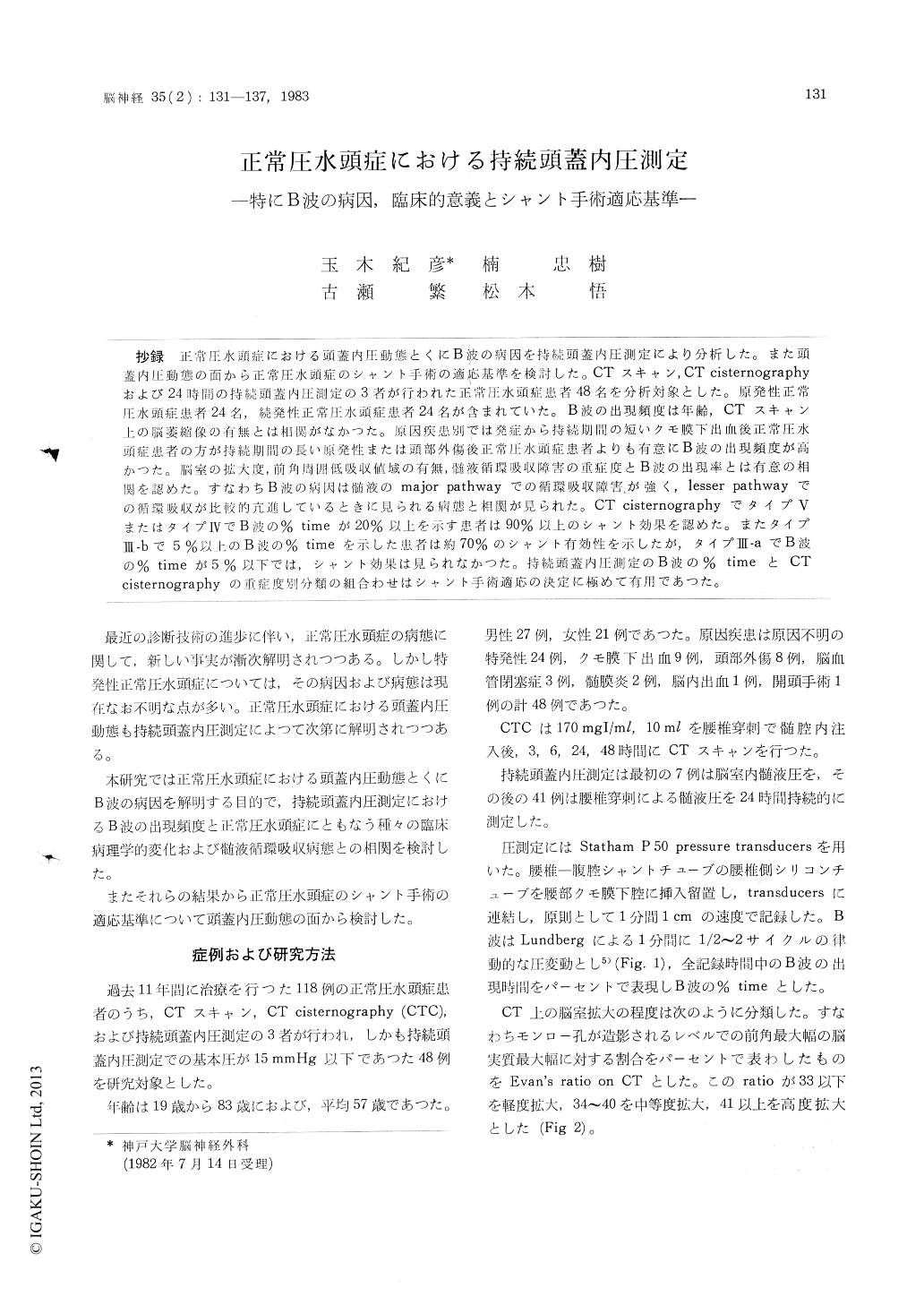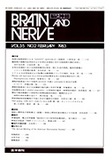Japanese
English
- 有料閲覧
- Abstract 文献概要
- 1ページ目 Look Inside
抄録 正常圧水頭症における頭蓋内圧動態とくにB波の病因を持続頭蓋内圧測定により分析した。また頭蓋内圧動態の面から正常圧頭症のシャント手術の適応基準を検討した。CTスキャン,CT cisternographyおよび24時間の持続頭蓋内圧測定の3者が行われた正常圧水頭症患者48名を分析対象とした。原発性正常圧水頭症患者24名,続発性正常圧水頭症患者24名が含まれていた。B波の出現頻度は年齢,CTスキャン上の脳萎縮像の有無とは相関がなかつた。原因疾患別では発症から持続期間の短いクモ膜下出血後正常圧水頭症患者の方が持続期間の長い原発性または頭部外傷後正常圧水頭症患者よりも有意にB波の出現頻度が高かつた。脳室の拡大度,前角周囲低吸収値域の有無,髄液循環吸収障害の重症度とB波の出現率とは有意の相関を認めた。すなわちB波の病因は髄液のmajor pathwayでの循環吸収障害が強く,lesser pathwayでの循環吸収が比較的亢進しているときに見られる病態と相関が見られた。CT cisternographyでタイプVまたはタイプIVでB波の%timeが20%以上を示す患者は90%以上のシャント効果を認めた。またタイプⅢ—bで5%以上のB波の%timeを示した患者は約70%のシャント有効性を示したが,タイプⅢ—aでB波の%timeが5%以下では,シャント効果は見られなかつた。持続頭蓋内圧測定のB波の%timeとCTcisternographyの重症度別分類の組合わせはシャント手術適応の決定に極めて有用であつた。
The authors investigated the hydrodynamics in normal pressure hydrocephalus (NPH) and suggest-ed surgical indication for identifying cases suit-able for shunt operation.
48 patients with presumed NPH who underwent CT scanning, CT cisternography, and continuous monitoring of intracranial pressure for 24 hours were studied for assessing the correlation of in-cidence of B wave with clinicopathological fea-tures of the normal pressure hydrocephalus syn-dromes.
The causes of NPH consisted of idiopathic of primary origin in 24 patients, subarachnoid he-morrhage in 9, head injury in 8, cerebrovascular occlusion in 3, meningitis in 2, intracerebral he-matoma in one and craniotomy in one.
The incidence of B waves in term of percent-age of time with B waves did not correlate with the age of the patients and presence or absence of CT evidence of brain atrophy.
There was a good correlation between inci-dence of B waves and the degree ofventriculo-megaly, the presence of periventricular lucency on CT, and the grade of CSF circulation disturb-ance as evaluated by CT cisternography.
The pathogenesis of B waves may be related to increased malabsorption of CSF in the major pathways and episodic pressure response prcmo-ting CSF absorption in the lesser pathways.
Those patients who exhibit the type IV or type V on CT cisternography and B waves for more than 20% of the time monitored on continuous monitoring of intracranial pressure (ICP) respond-ed to shunting in more than 90%. Patients show-ing type III-b on CT cisternography and B wa-ves for more than 5% on ICP monitoring benefited from a shunt in about 70%. On the other hand, patients with type III -a on CTC and B waves for less than 5% of the time monitored could not be expected to respond to shunting.
Incidence of B waves on continuous ICP moni-toring correlated closely with response to CSF shunting.
Therefore continuous ICP monitoring, combined with CT cisternography, provide a reliable indi-cation of the potential of a patient with NPH to recover after shunting.

Copyright © 1983, Igaku-Shoin Ltd. All rights reserved.


